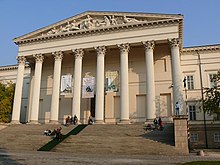Hungarian National Museum
The Hungarian National Museum (Hungarian: Magyar Nemzeti Múzeum ) in Budapest has collections of various objects from Hungarian history .
location

The main building is located at the 'Múzeum körút' in the 8th district . Accessibility by public transport (see BKV Zrt. ):
- with metro line 3 ( Kalvin tér stop )
- with metro line 2 ( Astoria stop )
- with bus lines 9 and 15
- with tram lines 47 and 49
The Castle Museum in Esztergom ( Magyar Nemzeti Múzeum Esztergomi Vármúzeuma ) also belongs to the National Museum.
history
At the beginning of the 19th century, the reflection on nationality in Hungary was reflected in the establishment of two important institutions, both of which are connected with the name Széchényi . The first impetus for the construction of the museum came in 1802, the same year as the establishment of the Széchényi National Library , when Count Ferenc Széchényi donated his private library to the country. The proposal to found the National Museum, to which Széchényi also donated his collection, came from Archduke Joseph Anton .
The building site was purchased in 1813. The classicist building was designed by Mihály Pollack . The construction work, financed with international donations, finally began in 1837. The first collection moved in in 1846, one year before the final completion. Because of the difficult financial situation, the museum could not be built from expensive materials. In this respect, the building lagged behind other neoclassical buildings of the time, with which the museum can, however, compete in every other respect.
The main entrance follows the famous model of the Athenian Erechteion . The portico is characterized by a pediment supported by eight Corinthian columns. The group of statues depicted on it was made by Raffaello Monti based on a design by Mihály Pollack. In the middle sits the female figure of Pannonia, on her right are the allegories of science and art, on her left the allegory of history and the embodiment of fame with a laurel wreath. The figure on the right edge symbolizes the Danube , the figure on the left outer edge stands for the Drava . The ornaments inside the museum were worked out by Mór Than and Károly Lotz . The coffered ceiling in the neoclassical domed hall should be emphasized .
The National Museum became a starting point for the Hungarian Revolution of 1848 . On March 15, 1848, the Nemzeti dal (“National Song”) and the 12 points with the title Mit kíván a magyar nemzet (“What the Hungarian Nation Wishes ”) were announced on the podium of the stairs in front of the main entrance . On April 11, 1894, the remains of Lajos Kossuth were laid out at the National Museum, Mór Jókai saying farewell on behalf of the nation.
Until 1933 the collections of the Hungarian Natural Science Museum were an integral part of the National Museum. The building suffered severe damage during the Second World War . It was therefore rebuilt in 1948. The building has been restored again in recent years.
Collections
- On the border between Orient and Occident
- Roman, medieval and early modern lapidary
- Hungarian coronation mantle
- Hungary's history from the founding of the state to 1990
- Hungarian Scientists - "Who Made the 20th Century"
Departments
- Main Archaeological Department ( Régészeti Főosztály )
- Medieval main department ( Középkori Főosztály )
- Modern Main Department ( Újkori Főosztály )
- Modern main department ( Legújabbkori Főosztály )
- Historical picture gallery ( Történeti Fényképtár )
- Coin Collection ( Éremtár )
- Historical picture hall ( Történeti Képcsarnok )
- Central Library ( Központi Könyvtár )
- Central database and main IT department ( Központi Adattár és Informatikai Főosztály )
- Main Department of Restoration and Preventive Conservation ( Restaurátor és Műtárgyvédelmi Főosztály )
- General Education Department ( Közművelődési Főosztály )
General Directors
- 1808–1823: Jakob Ferdinand von Miller (1749–1823)
- 1837–1843: János Horváth
- 1843–1869: August von Kubinyi (1799–1873)
- 1869–1894: Ferenc Pulszky (1814–1897)
- 1894-1916: Imre Szalay
- 1923–1932: Bálint Hóman
- 1951–1986: Ferenc Fülep (1919–1986)
- 1986–1993: István Fodor
- 1993–1999: István Gedai
- 1999–2010: Tibor Kovács (1940–2013)
- 2010–2016: László Csorba
- 2016 – today: Benedek Varga
Individual evidence
- ↑ Somorjai in 287-88.
- ^ Ferenc Fülep: The 175 years of the Hungarian National Museum. In: The New Hungarian quarterly 19 (1978). P. 164.
literature
- The Hungarian National Museum. Edited by István Fodor. Corvina Verlag, Budapest 1992. ISBN 963-13-3749-9 .
- László Éber (Ed.): Művészeti lexikon . 2nd Edition. Budapest 1935, ISBN 963-9497-56-8 , pp. 314-315 (Hungarian).
- Ferenc Somorjai: Budapest . 2nd Edition. Panoráma, Budapest 1996, ISBN 963-243-766-7 , p. 287-292 (Hungarian).
Web links
- Homepage of the Hungarian National Museum. Magyar Nemzeti Múzeum, accessed on November 19, 2008 (Hungarian, German, English, Italian, Spanish).
- Aerial photography. Civertan Bt., Accessed November 19, 2008 (Hungarian).
Coordinates: 47 ° 29 '27.3 " N , 19 ° 3' 43.8" E


